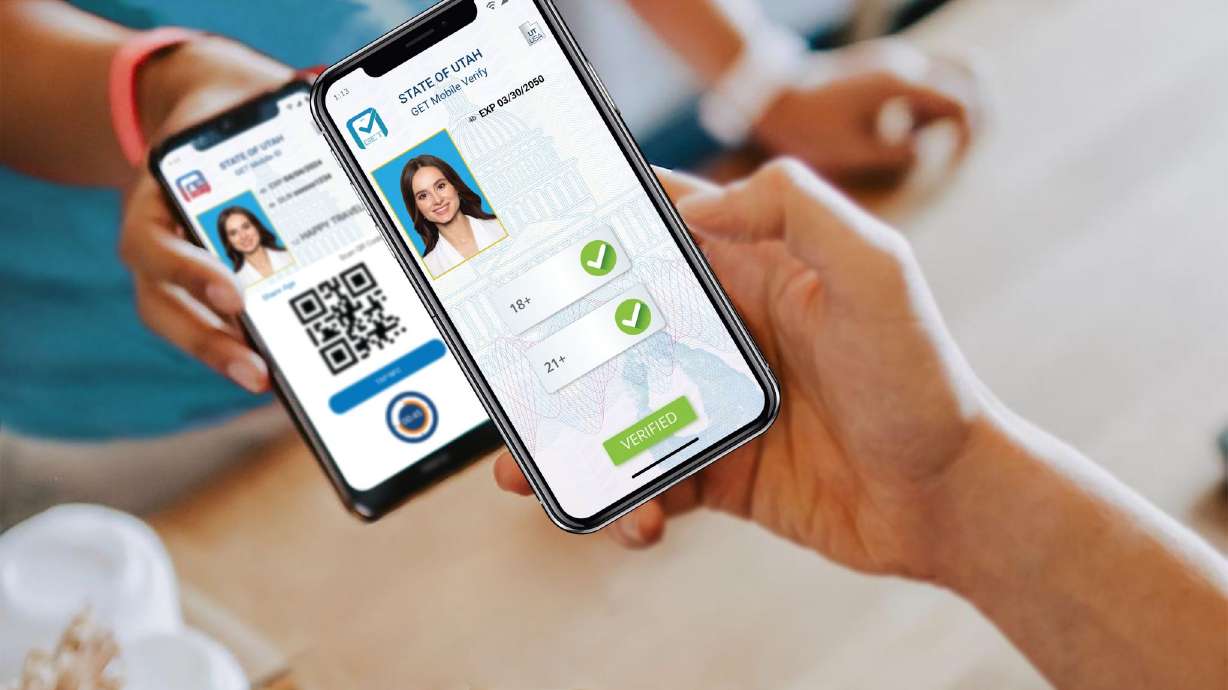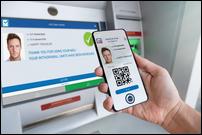Estimated read time: 7-8 minutes
This archived news story is available only for your personal, non-commercial use. Information in the story may be outdated or superseded by additional information. Reading or replaying the story in its archived form does not constitute a republication of the story.
SALT LAKE CITY — The future is here.
More than 500 Utahns have already enrolled in the state's new mobile driver's license program, but that number is expected to grow into the thousands by the end of the year, according to the Utah Public Safety Driver's License Division and the Massachusetts-based company behind the new technology.
David Kelts, director of Mobile ID Product Development for GET Group North America, estimates that more than 1,000 mobile licenses will be set up in Utah by the end of the week and over 10,000 mobile licenses before the process is available to everyone statewide at the start of 2022.
As the future of mobile driver's licenses in Utah becomes ever more present, here's a look at exactly how it works and how it will be implemented in the coming years.
What is a mobile driver's license?
The Utah Department of Public Safety launched the mobile driver's license pilot program earlier this year following a bill the Utah Legislature passed in 2019. The program is perhaps the biggest innovation to Utah driver's licenses since they were first required in 1933.
Using an app created by GET Group, a Utahn can hold and share their license just from their cellphone. Ryan Williams, the quality assurance manager for the Utah Public Safety Driver's License Division, argues that a mobile license offers the convenience of having identification on your cellphone, contactless information transfers and also enhanced privacy, such as information Utahns can choose to provide or hide.
For instance, someone purchasing alcohol from a store can share a QR Code that verifies the customer's name and if they are 21 or older. They don't have to share any other information, such as their home address or date of birth.
Kelts said the information on the app and sent from a phone is encrypted to ensure it's kept secure. The app also produces a new bar scan code every time it's used so it can't be copied and reused by anyone. Anytime a user prompts a QR Code, it also must be scanned within a minute or they have to use a new code.
Aside from a limited-term license, the plan is that there will be a mobile option for all Utah-issued licenses and identification cards by next year.
How to get it now and use it
Utah Community Credit Union in June became the first Utah business to announce it would accept a mobile driver's license as an acceptable form of identification. Harmons is the second business and the first Utah grocery chain to do the same. The grocer will accept a mobile license to verify identity for any pharmacy purchases or age-based purchases — like alcohol — at its City Creek and Traverse Mountain locations beginning this week.
However, Utahns who want to get a mobile license now can only get one through Department of Public Safety events held at UCCU and Harmons. The department held one of those events on Tuesday and will hold another from 10 a.m. to 2 p.m. Wednesday at the two Harmons locations accepting mobile licenses.
Related:
A person with a valid Utah license can show up and scan a QR Code that takes them to a site where they can download the GET app. From there, employees from the driver's license division plug in information from a person's physical card into their system. It ends with employees doing one last check to confirm the person's license through a QR Code scan in the same way a business would read a license.
The whole process to get a mobile license takes about two or three minutes. Williams said that the enrollment events have only been held at UCCU and Harmons locations so far because it made sense to only offer enrollment where people could actually use a mobile license.
Once added to the system, a user can access their license through the GET app. It's available by simply opening the app. There, users can tap a section that produces a QR Code that an employee from, say Harmons, can scan using a tablet.
"It's going to be a different process than you traditionally used. Right now, if somebody asked for ID, we'd get our wallet out, they verify who you are, take a look, they may check security features on the card to make sure the card's real," Williams said. "With mobile ID, it's contactless. You never hand your phone over to somebody and you shouldn't be showing somebody the picture in your ID to that person. You're actually going to show them a QR Code and that QR Code will verify, with our system, who that is and pull their information in from the driver license division."
The employee will only see the information they need, such as if the customer trying to purchase alcohol is at least 21. It's a process that should take seconds.
But that's just the beginning. Leaders from both GET Group North America and the state's Driver's License Division envision a completely different future of licenses than what Utahns have used for nearly a century.
Harmons is among Utah companies looking to integrate mobile licenses into their system that won't even require an identification check from an employee, according to Williams.
"As you're scanning your items, we can have you just scan the bar code on your phone as a part of the process and it makes that continuation go a lot smoother," he said, adding that it should save time for customers who won't have to wait for a store employee to plug their date of birth into a computer or spend time looking at a card to make sure it's authentic.
Utahns may not have to worry about having their QR Code scanned either. Another function being tested would allow mobile license users to share their encrypted information through near-field communication or Bluetooth. It's a function that could come to law enforcement in the near future.
"We're pretty close to having it. We've done some demonstrations and we're testing that right now," Williams added. "That seems to work, where I can ping a device from afar."
What's next for the program?
UCCU and Harmons may be the first two businesses to accept mobile licenses but they aren't in line to be the last. Williams said the Utah Department of Alcoholic Beverage Control is planning to apply the technology, which could come to all liquor stores statewide, in the coming months.
There's also a plan to reveal a new Utah business that will accept mobile licenses every month to close the year, according to Kelts. Those could include convenience stores, restaurants and hotels.
The Utah Highway Patrol and various local police agencies are also interested in its potential.
I think it's a big convenience for people to leave their wallets at home. And I think the additional control over data will end up being important for people.
–David Kelts, director of Mobile ID Product Development for GET Group North America
Meanwhile, there will also be different ways for Utahns to get a mobile license by the end of the year as the pilot program slowly turns into a regular feature offered by the state. The app will soon be available through app stores and, over the next few months, Kelts said, Utahns will have three options to set up a mobile license.
An eligible person could go to a state driver's license office and go through the same short process as at the Harmons event. Utahns will also have the option to create one through a signup page.
"You go to the signup page, enter your email address and phone number, and that will kick off the process," he explained. "In that case, it's a biometric match, a selfie match back to the driver's license record."
The third option involves just the app and a physical license. A Utahn can download the GET app, scan the front and back of their license, scan their face and the app will match those together to prove identity and complete the digital license.
Utahns should have all three options available to them by the start of 2022, which is when mobile licenses will be made available. In addition, any changes a user makes to their physical card will also be made automatically in the app, according to Williams. That means a user won't have to worry about updating their mobile license after they switch their address or renew their license.
Kelts envisions mobile licenses as not just the future of Utah but also the future throughout the globe. In addition to Utah, GET Group is also testing out the technology in Sweden. If all goes as planned, the technology won't just be for use within the state but across borders, too.
"I think it's a big convenience for people to leave their wallets at home," he said. "And I think the additional control over data will end up being important for people."










